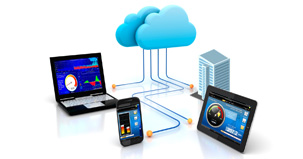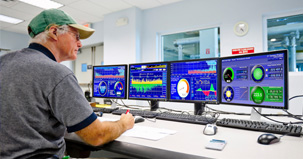- Home
- Smart Data
Smart Data
Actionable intelligence on energy and water use:
- Helps users identify inefficencies, and waste
- Provides real-time feedback on conservation
Right data for the right audience:
- Facility managers identify when and where energy is wasted
- CFO's can track and verify financial savings from initiatives
- Company knows its carbon and water footprint
Related Products
 Information any time, anywhere
Information any time, anywhere - Smart User
Smart User
Smart users leverage real-time data and reduce energy and water use by:
- Continuously identifying opportunities
- Acting on opportunities
- Tracking and verifying savings
- Sustaining savings
Related Products
 Monitor, Manage, Maintain
Monitor, Manage, Maintain - Smart Community
Smart Community
A smart community is one where all stakeholders are engaged in energy and water conservation. A smart community can be achieved by:
- Showing people precisely how much they are using
- Providing real-time feedback on conservation actions
- Effectively communicating efficiency results
Related Products
 Communicate and Conserve
Communicate and Conserve - Smart Grid
Smart Grid
Smart grid, as we define it, is a "green grid", with efficient resource use and the key to a low-carbon future. We help our customers prepare for the smart grid by:
- Engaging users with smart data
- Enabling smart users to increase resource efficiency
- Educating & empowering smart communities
Related Products
 Smart grid and a smarter future
Smart grid and a smarter future - Smart Buildings
Smart Buildings
Smart buildings maximize resource (energy, water, capital) efficiency. These buildings are optimized using energy and water management process with high data visibility which lead to reduced energy and water spending.
- Higher operating income and higher asset values for owners
- Increased productivity for occupants
- Lower carbon footprint for the community
 Resource efficient buildings
Resource efficient buildings
Subtitle!
Recent Posts
ISO 14000 - Framework for Common Environmental Goals
It is hard to believe there was a time when we, as a united people on Planet Earth, didn’t really focus on the environment. However, it really wasn’t until 1970 that the collective global eye turned towards the environment and how the global human footprint was making a forever-impact.
In 1972, the United Nations took notice and held the Conference on the Human Environment. Soon enough, diverse constituencies ranging from companies and regulatory bodies to consumers and activists realized there had to be a common framework for talking about the environment, monitoring impacts, and improving how human beings treat the only planet we call home.
It took almost 25 years but, in 1996, the United Nations was able to pass the ISO 14000 family of standards. Today, it is used in about 160 nations. ISO 14000 mirrored what ISO 9000 standards accomplished for quality. Thanks to ISO 9000, everyone, no matter the nation, industry, company, or department, approached quality from the same points of reference.
The ISO 14000 series was developed by the International Organization for Standardization as a multi-purpose tool. To begin with, standard concepts and terminology was created to allow many countries to “speak the same language” when it came to organizational processes and how they were affecting the environment.
It stands to reason that if it could work for global quality issues, it could work for common goals relating to the environment. That’s why, when it comes to sustainability, with a common framework, the private sector, government, and nonprofits can also make faster progress. With these standards in place, countries and companies can address these issues more easily internally as well as externally with international and nation regulatory bodies, consumers, the public, and funding sources -- be they investors or foundations.
Secondly, the basic ISO 14001 standard provides guidelines for improving environmental performance. Participation is voluntary. The initial step is a review or gap analysis of all the organization’s processes and what might be on the drawing board. It’s a broad set of guidelines -- extending from internal operations such as production to sourcing of raw materials. However, it works because, based on the findings, targets are established. Such analysis and goal-setting also serve as a standard way to comply with and report to regulatory bodies and conduct remedial action.
The third way the tool works is through implementing the plan. Seems obvious, but that’s a major undertaking. Executives have to buy in and then employees have to be trained. A new language is introduced and then systems, procedures, and practices are modified or eliminated if they fail to meet goals. Finally, measurement becomes routine.
The fourth function is continuous improvement. Usually that includes expanding the effort and raising the bar on expectations. At that point, the organization builds sustainability into its overall strategy. There it can become innovative and perhaps even launch breakthrough approaches.
The payoff of basic ISO 14001 can be profound.
- Organizations have clear guidelines for establishing environmental policy.
- Process changes usually reduce electricity costs.
- Compliance and reporting are easier and less expensive.
- Stakeholders are satisfied that sustainability is being addressed and the risk of environmental crisis minimal.
The other ISO 14000 standards are applied for specific functions such as labeling and auditing.
Global standards forge common goals, that’s for certain. But the real work starts at home – in your own backyard. As you “go global’ with your environmental efforts, take the time to measure energy use to make sure your own companies’ systems are in order. A properly working HVAC system, for example, will keep occupants cool in the summer and warm in the winter. However, perhaps most importantly, it will keep utility costs under control every season of the year.